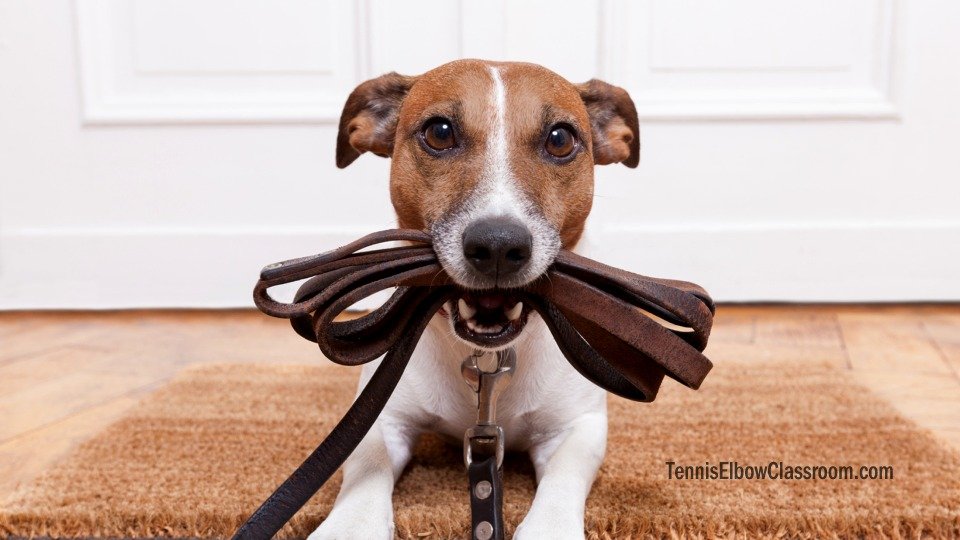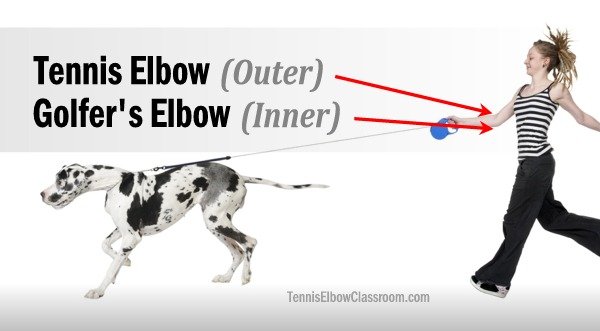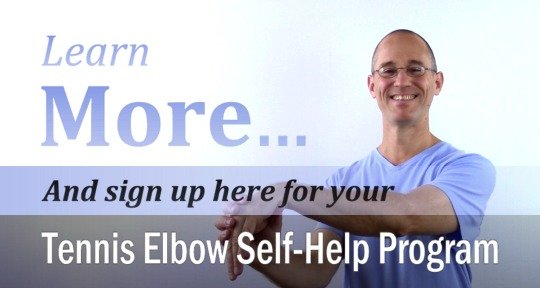
It’s a beautiful day and you’re out enjoying it, walking your dog.
Distracted momentarily, as you fumble to answer your phone, you’re suddenly jerked forward by the leash… Your dog has bolted in pursuit of a distant, furry rodent and has taken you along for the ride!
You feel a sharp, sudden pain in your hand, elbow and shoulder from the leash, wrapped around your wrist – and later that night it’s aching so badly you can’t even sleep.
So, Your Arm Hurts From Your Dog Pulling On The Leash
Or maybe there was no specific, sudden “event” and your problem seems to have crept up on you from simply holding and pulling on your dog’s leash day after day…
Perhaps exacerbated by countless hours of tossing a tennis ball to your dog.
And what you feel is that your hand, wrist and/or elbow has become increasingly sore and painful.
And the muscles in your forearm have become so persistently tight they never seem to fully relax!
Either way, whether it happened quickly – from a big, sudden jerk on the leash…
Or slowly – from countless hours gripping and pulling that leash and tossing tennis balls…
You may be suffering from the modern malady known as “Dog Walker’s Elbow!”
The sad result being that what was once a fun and relaxing activity, you looked forward to every day with your dog, has become painful drudgery.
And unlike obvious acute injuries often suffered by people walking their dogs, like sprains, fractures and joint dislocations, which require immediate medical attention…
It’s all too easy to fall through the cracks of “Modern Medicine” when you’re suffering from a chronic dog walking injury of your wrist, elbow or shoulder.
What Is Dog Walker’s Elbow?
The classic Dog Walker’s Elbow comes about as a result of months or years of holding and pulling on a leash. (Or should I say “being pulled ON?”)
Or sometimes it can arise – OR flare up suddenly – from a big jerk on the leash, as we covered.
It’s typically either:
- Tennis Elbow / ‘Lateral Epicondylitis’ – If it involves pain and injury to the tendon attaching to the little bony knob at your outer elbow (Lateral Epicondyle) OR…
- Golfer’s Elbow / ‘Medial Epicondylitis’ – If it involves pain and injury to the tendon attaching to the little bony knob at your inner elbow (Medial Epicondyle)

Yes, you can get Tennis Elbow OR Golfer’s Elbow from walking your dog
So, it’s really about where the injury IS that defines the injury – Not the activity.
You can still call it “Dog Walker’s Elbow” if you want but, technically, it’s probably either Tennis or Golfer’s Elbow.
Chuckit Elbow! (Or Ball Toss Arm)
Chuckit Elbow is another name for a Tennis Elbow injury that arises from the repetitive motions involved in throwing a tennis ball with a Chuckit or similar ball-tossing device.
Playing fetch with your dog using one of these ball tossing tools is, unfortunately one of the fastest and “easiest” ways to develop Tennis Elbow.
(And this can also happen simply throwing a ball to your dog by hand) – However…
There is something especially pernicious about the motions involved in using a Chuckit or similar ball tossing device.
Especially if you make a “snap” with your wrist to release the ball at the end of the throwing arc.
Repeat this enough times and it overloads the wrist extensor muscles and their tendon origin at the Lateral Epicondyle / outer elbow.
Yes, the advantage of using a Chuckit is that you won’t have to bend over as far to pick up (or touch) the slobbery ball…
And that you can throw the ball farther than you can by hand.
However, this may not be the best thing for your dog. According to this article:
“Long-range ball throwers are great for wearing out energetic dogs and keeping hands clean… but for all their ease, they might also be causing irreparable damage…”
[The article quotes a UK veterinarian who’s alarmed by how many pet owners repeatedly launch balls at high speeds to their dogs until they collapse from exhaustion.]
“…this sort of repeated exertion can unnecessary strain on their joints, muscles, and cartilage, and can result in long-term health problems like arthritis.”
Long-Range Ball Throwers are Damaging Dogs’ Joints, Vet Warns
Since the natural throwing motion is much easier on your arm, (and, potentially, your dog) here’s a compromise:
Chuckit TIP: Use the Chuckit to easily pick the ball up off the ground, but take the ball and throw it by hand instead of with the Chuckit.
The Symptoms
Whether you have Dog Walker’s or Chuckit Elbow, the symptoms are essentially the same.
- Persistent muscle tension, fatigue and soreness – In your forearm and possibly your upper arm or shoulder
- Burning pain – At your inner elbow (Golfer’s Elbow) or outer elbow (Tennis Elbow) which can feel like the bone is “on fire”
- Startling, unexpected jolts of sharp pain – when you pick things up, turn doorknobs and, of course, walk your dog on leash!
The symptoms may come on suddenly after a particularly hard jerk on the leash, but they often start gradually and worsen over time.
The Misunderstood Nature Of The Injury
The nature of the dynamic causing Tennis or Golfer’s Elbow, whether from tennis, golf or dog walking leash injury is the same…
However, it’s often misunderstood and misrepresented as an inflammatory “Tendonitis” problem.
And this may be partially accurate in the earliest stages.
You might have a little inflammation in your tendons, at first – But that’s not a bad thing!
You see, inflammation (although demonized and attacked) is actually a stage of your healing process.
And if your tendons are getting inflamed it’s a sign that your body is trying to heal them.
Inflammation is NOT the problem.
The problem – especially with tendons – is that they often fail to heal.
What you can end up with, especially after several months have passed, is a state of degeneration.
And inflammation has “left the building”…
Essentially, the healing process stalls and fails, and instead of healing and repairing, your tendon starts breaking down.
Instead of the “house is on fire!” imagery often portrayed, visualize the foundation slowly rotting away.
Why Do Tendons So Often Fail To Heal?
If the body can heal most tissues, (which it can, with a few exceptions) why is it that tendons are so much at risk of not healing and slipping into a state of degeneration!?
Now, that’s the million dollar question!
I can’t claim to have the whole answer to that.
(But neither can medicine. Medical research has been going on for decades in this area.)
They did figure out back in the 70s that most chronic tendon disorders, like Tennis Elbow, were degenerative in nature, not inflammatory.
Technically, TendinOSIS – Not TendinITIS.
However, this knowledge is still not as widespread as it needs to be!
You will STILL be advised to:
- Take anti-inflammatory pills
- Ice your tendons every day
- Wear a brace around all the time
- And get Cortisone Shots if the pain persists
ALL in the name of treating and defeating this non enemy: Inflammation.
(The brace may not be directed at inflammation but it’s still treating the problem as if it were an acute injury, rather than a chronic one, which is part of the misunderstanding.)
How To Treat The Underlying Cause
From my perspective, (and I’ve been helping people with Tennis and Golfer’s Elbow in person and here on this site for 15+ years)…
It’s obvious that the problem starts in the muscles.
In the case of Golfer’s Elbow, we’re talking about the muscles of the hand and fingers that you use to make a fist and grip things, which are mostly in your inner forearm.
In the case of Tennis Elbow, we’re talking about the muscles of the hand and fingers in your outer forearm, which open your hand and extend your fingers.
And these muscle groups have there ‘Origins’ – Their “upstream” attachment tendons at your inner and outer elbow, respectively.
When muscles get “overused,” fatigued and weakened, they get tense.
And when tension persists muscles have a tendency to develop adhesions.
Adhesions are basically layers of tissue sticking together.
The can happen quickly, via Scar Tissue, in the event of a sudden, acute injury, like a cut or tear.
Or, in this case, very slowly over weeks, months and years.
The consequence is that the muscle gets progressively shorter and more restricted.
And this persistent tension eventually begins to harm the tendon(s) the muscle is connected to.
Again, those ‘origin’ tendons are “upstream” at the inner or outer elbow, which are the locations of the Golfer’s and Tennis Elbow “spots.”
At first, there may be some inflammation as your healing process kicks in…
But if the excessive load on the tendon continues, healing often fails to keep pace with the damage and the tendon often degenerates (breaks down.)
The solution, from my perspective, has 3 main parts:
- Release the chronic tension and muscle adhesions – using a particular advanced massage (or self-massage) technique, known as ‘Pin And Stretch’
- Stimulate the tendons – with a different advanced massage (or self-massage) technique called ‘Cross Fiber Friction’
- And carefully strengthen the muscles and tendons – But only after the vicious cycle of muscle restriction and tendon breakdown subsides
See my article on The Best Self-Massage Techniques here for more
The conventional approach not only misses the mark – It does more harm than good…
By blaming inflammation (a symptom of healing) and then attacking it with pills, shots and ice.
Thereby suppressing the very healing response needed to repair the tendon…
And, instead of mobilizing, releasing and stimulating the muscles and tendons, the area is often immobilized with a brace…
Guaranteeing the worst possible situation: Lack of circulation, a suppressed healing response, restricted movement and an overall state of stagnation.
And, since stagnation and degeneration are kissing cousins, the result tends to be more degeneration…
Yet, all the while, if you’re going down this road, you may think it’s getting better, because it’s feeling better…
But, of course, that’s only because of all the symptom suppression and lack of movement.
And, eventually, when the brace comes off and you try to strengthen it in Physical Therapy…
It flares up worse than ever…
Because it IS weaker and worse than ever!
And the vicious cycle continues.
OR you can break that cycle by taking a more “healing supportive” strategy.
Here’s where you can learn more about the Tennis Elbow Classroom Treatment Strategy
And below you’ll find links to my home programs if you need a complete guide to overcoming and fully recovering from your injury. (Scroll to the end of the article, below the following tips.)
Tips On Avoiding Leash-Related Injuries
One of the first steps to avoiding leash-related injuries is to have the right leash type and length.
Retractable Leashes: Many dog trainers and professional dog walkers seem to agree that the retractable leash is an invitation to injury – for both people AND their dogs.
Retractable Leashes Dangerous To Humans And Dogs
Correct Leash Length: Another key consideration is “How long is your leash?”
The longer your leash the more speed and momentum your dog can build up before reaching the limit of the leash and potentially dislocating your shoulder if you have a large dog!
Here’s a Guide To Choosing The Best Dog Leash
Don’t wrap the leash! Wrapping the leash around your wrist or hand won’t give you the option of letting go of the leash if you have to.
If your dog takes off or the leash gets tangled up with another dogs leash your wrist or hand could get crushed and/or sprained and you could end up falling.
Fingers under collar: Don’t put your fingers under your dog’s collar. If your dog takes off you could end up with a dislocated or even broken finger.
Ergonomic leash holder: Consider getting something like The Gizmo, a multifunction leash holder. It gives you a round, cushioned, hand-sized grip to hold on to, which is better for your fingers and thumb that holding a typical leash.
More about Gizmo, Multifunction Leash Holder
Learn To Treat And Heal Your Own Tennis Elbow, Golfer’s Elbow, Wrist Or Finger Tendinosis
You’ll get instant access to a complete VIDEO program designed by a professional therapist to help you take charge and break your vicious cycle of pain and frustration!…I’ll be your personal tutor guiding you through step-by-step video lessons, where you’ll get the therapy techniques, key stretches and essential exercises you need to treat and recover from your injury at home. (Without any special equipment.)
Tennis Elbow sufferers: Learn more about the Tennis Elbow course here
Golfer’s Elbow sufferers: Learn more about the Golfer’s Elbow course here







Leave a Reply